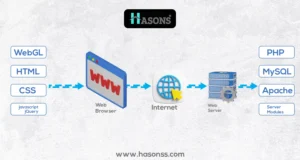What is Web Technology?
Here the explanation of What is Web Technology? Some facts you may not be aware of: The internet has over people are using the Internet to find some information and you are aware that more than 1. 7 billion websites? This provides the architectural framework to a huge intervening cyber-space Web technology is the main element of this worldwide web, for constructing flashy sites and applications. Some of its aspects are frontend and backend development, databases, and web protocols are some of the items under this class.
By understanding that web technologies enable effective websites and apps more is made. This includes Internet, digital technologies, and web programming as a few examples of areas that the program encompasses. These fields contribute to the formation of the digital reality that exists now.
Understanding Web Technology
Web technology has two main parts: The frontend and the backend The frontend and the backend refer to two distinct elements in the design and approach of an application. Both of them work together to show how the interface in the background looks on the screen of the computer and link the events that occur on the server. Ninger like HTML, CSS, and JavaScript adds the aesthetic value of Web frontend languages to the functionality of the site. Generally, at the backend level for the whole work and data processing, sometimes PHP, Python, or Java languages are used.
The following operation involves databases coming into play as well. It allows web applications to both store and retrieve information smoothly. Such platforms or rather databases such as MySQL, PostgreSQL, and MongoDB are the keys for this. The clients, as seen earlier, can use protocols like HTTP or HTTPS to communicate with the server seamlessly. It ensures that there is efficiency and security in data exchanges. These components of web technology cooperate. They create the exciting user experiences that we can find on the web today. The knowledge of web technology is important to those who are developing websites. It provides them with the necessary resources for constructing and maintaining the sites or applications that they consider efficient.

| Web Technology
Components |
Description |
| Frontend Development Languages | HTML, CSS, and JavaScript – responsible for the visual and interactive elements of a website or web application. |
| Backend Development Languages | PHP, Python, Java, and Node.js – used to process data, manage databases, and power the underlying functionality. |
| Databases | MySQL, PostgreSQL, and MongoDB – used to store and manage data for web applications. |
| Web Protocols | HTTP and HTTPS – facilitate communication between the client (user’s web browser) and the server. |
The Classification of Web Technology
Types of Web technology can be categorized into different sections to indicate the various tools and components of the modern world. It includes:
Front-end Web Technologies: This group is responsible for the section that users interact with, which is called the client-server division. HTML stands for Hypertext Markup Language while CSS stands for Cascading Style Sheets and the other part of Web Scripting Language is JavaScript. They are responsible for the appearance and usability of a site or app.
Back-end Web Technologies: The part that takes place on the web server is called the back end or server side. They employ programming languages including PHP, Python, Java, and Node among others. js. They control and manipulate the site’s content and services, which are not visible to the user.
Database Technologies: Among these components, databases are one of the most important, leveraging technologies like SQL and NoSQL. These involve holding and filing the massive data required by applications and platforms.
Web Protocols and Standards: Technique norms consistent with the protocol include Hypertext Transfer Protocol (HTTP) and Hypertext Transfer Protocol Secure (HTTPS). Such protocols ensure data that is being transmitted between the clients and servers is done effectively. They also established the rules about using digital technologies.
Web Frameworks and Libraries: Symbol, Bootstrap, Foundation, jQuery, Backbone, Node.js, PHP js, and Laravel are some of the tech used here. There are also multiple ready-made solutions to help address different needs and thus ensure faster build times. This helps prevent the rewriting of scripts or the coding of similar functionalities over and over again.
History of Web Technology
The World Wide Web began to be widely utilized in the early 1990s. The developed graphical browsers such as Mosaic, and Navigator also assisted users to navigate fluently on the web.
From the mid of the 1990s, novelties such as the cascading style sheets and JavaScript initially altered the looks of websites. These technologies made sites more useful and allowed for increased interactivity. Technologies like PHP and Python enabled different and dynamic server-side applications.
In the coming years, specifically in the 2000s, Web 2. 0 called for user participation and social media. Frameworks, systems, and cloud computing came up to enhance web technology. This made web tools as easy to use for developers as well as the users at large.
As of now, web technology continues to rise with more solutions. Some of these are; responsiveness, Single-page applications, and Artificial intelligence. The web is a lot less flat and a lot more tailored now.
Frontend Development Languages
Frontend development languages build the look and feel of websites. They are vital for the user interface. The main languages are:
| Language | Description |
| HTML (Hypertext Markup Language) | HTML creates the structure and content of web pages. It has elements for headings, paragraphs, lists, and links. |
| CSS (Cascading Style Sheets) | CSS gives style and format to web pages. It lets developers manage layout, colors, and fonts. |
| JavaScript | JavaScript adds life to web pages. It makes pages interactive with things like menus, sliders, and form checks. |
HTML, CSS, and JavaScript team up to shape how websites and apps look and work. They are key client-side web languages. These tools improve user experiences, making digital platforms more fun and efficient.
Backend Development Languages
Backend development languages operate the back-end basis for a website. These access and manage the data of a site. Popular languages that are used include PHP, Python, Java, Ruby, Node and many more JS.
PHP, (personal home page or hypertext preprocessor), is the base of many web application solutions. It is also cherished for being simple to master and navigate. However, it is not bad with HTML as well. Some of the most popular web development platforms such as WordPress and Drupal web applications are developed using PHP.
Python plays many parts in web, data, and AI tasks to solve. It rises from the rest of the scripts by virtue of having quite neat and comprehendible code together with numerous extras. Its Django and Flask frameworks make it is easy to build web applications rapidly.
Java is used everywhere- from humble Web sites to immense systems. It is meant to be tough and must adapt to your needs in addition to working in every environment. Java is best suited for large Web applications. Here, frameworks like Spring and Play come in handy.

Ruby enhances programmers’ work productivity and efficiency. It puts a smile on everyone who wants to create not just any site but the site of their desire. Using Ruby on Rails is a favorite when creating for many people.
|
Importance of Web Technology
Web technology is central in our new world, how we live, work, and connect with others. It brings a wealth of benefits across many areas: It brings a wealth of benefits across many areas:
They help to achieve global connection and functional teaming. Thus, owing to such web technology which is powered by the internet, we are able to find information, communicate, and even make transactions. It has led to a global marketplace for ideas to circulate and for projects to extend across the continent.
Web tech helps in enhancing trade and business, and also in promoting entrepreneurship. Internet tools help firms establish their online presence, reach out to more consumers and customers, and function in leaner ways. Some of the areas affected are namely; Electronic Business, E-marketing, Cloud computing, and Teamwork systems.
It helps make educational content and knowledge more easily attainable. Online education enables learners throughout the world to get new training, and education and be able to learn for their whole life.
It is also the process that drives social transformation. Individuals can take action in times they could be supporting organizations, sharing their ideas, or raising awareness for issues. This results to a society with heightened and positive social sensitiveness.
To sum up, technology should play a significant role in the World Wide Web. Communication though it is unseen is fundamental to how we relate, work, learn, and advocate for change in the world. Thus, it has been cemented as a defining primary component of our daily interactions with reality, and with the world around us.
Conclusion
The World Wide Web would not be possible without Web technology. It enables development of the websites and apps that are dynamic to use as well as captivating. The frontend and backend development, also use of the databases and web protocols are part of this technology.
The web of technologies applied in the construction of these systems can be discerned from this summary. They encompass simple programming languages such as Assembly, C, and basic and high-level communication protocols.
This area is valuable for developing an understanding of web technology in web development and digital marketing. The web technology overview signals the importance of in fact: updating one with new trends and practices.
Web technology as a field of study is always advancing as it applies to the contemporary world. Yes, it will help going forward to enhance experiences when connecting to the internet. It is to note that, professionals and fans too can apply web technology to develop improved online solutions if they are informed.
What is Web Technology?
- What are examples of web technologies?Some examples of web technologies are HTML; CSS; Javascript; ASP, PHP, python; Ruby on Rails; Angular; React; and Node. js; MySQL and Mongo DB; RESTful; HTTPs.
- Why do we need web technology?We require web technology to build and maintain websites and web-based applications to support user engagement, data handling, secure communication, and other organizational online activities.
- What is a web technology course?A web technology course introduces techniques such as HTML, CSS, JavaScript, backend coding, databases, and web standards. Thus, it enables learners to develop, implement, and manage websites and apps to their optimality.
- What is Web technology in short?Web technology includes the methods, languages, and tools that are used in the construction of websites and web applications which cover the front-end, back-end, database, and communication layer.
- What is Web 5 technology?Web 5 technology” isn’t a widely recognized term. Typically, it might refer to future advancements There is not much awareness of what is referred to as “Web 5 technology. ” Usually, it can cover further development beyond trends such as AI, IoT, or increased personalization of the web experience.
